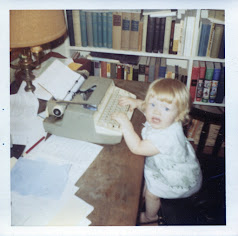In response to a message from a DNA match, I started looking a bit into my ancestor Ann White of Somerset, England. Ann was my 3rd great-grandmother, wife of Isaac Hobbs of the Hobbs branch that I've been told leads to Sir Edward Baytun. The marriage register entry connecting Ann to Isaac and the baptismal entries of their children are all I knew of her before this and although I'm not sure whether I know more about my Ann a week later, I'm nearly convinced.
The 1841 census of England was the first to record people by name and Ann, recorded in a household in the town of Elm that consists of herself, husband Isaac and six children, is already 50. Her entry in the 1851 census says she is 59, and the 1861 says 70, giving us a birth year, if all are accurate, of about 1791. The latter two census also record her town of birth as Elm/Great Elm.
Ancestry, so "helpfully", has provided me with a hint that takes me to a baptismal record and has even suggested parents for her. But there is a problem. The baptism that Ancestry dangled on that stick took place in Yatton- 30 miles away - and, if you read past the first line of the entry that contains the baptismal date of 17 Aug 1791 and the same parents as suggested by Ancestry, you will learn that this Ann was 26 years old! Sadly, there are at least three trees on Ancestry that have attached this record to the Ann married to Isaac Hobbs.
Going through the baptismal registers myself, I found in Elm, an Ann White who was baptized in 1795. She was the daughter of Charles and Martha White. Is this my Ann? The pieces fit so far, but the evidence is a bit thin. I'd love another document making the connection, but sometimes they just don't exist.
Ann and Isaac's marriage record did not record the names of their parents and the witness names were no help. Charles was a laborer, an edge tool maker, like his sons and generations of the Hobbs family, so was very unlikely to have had a will that might have linked him with Ann and her married name. Ann White is an awfully common name. I wondered if there was anything out there that would provide better evidence or more evidence.
When I was examining the census entries for the Hobbs-White family, I noticed other Whites on the same page. Could they hold the answer? This section of the census for Elm was only about sixteen pages in eight images, so I wrote down the given names of all the men with the White surname who were the right age to be Ann's possible siblings and then looked for baptismal records in the parish of Elm. Sure enough, I found baptismal records that matched the names of most of these men in years that matched their ages in the census, who also had the same parents as the Ann baptized in 1795.
Admittedly, I have not finished my Somerset county locality guide and I'm still learning my way around English research, especially before civil registration, so it was time to ask for help. Yesterday I posed my question in the "Somerset - Ancestors & Genealogy" group on Facebook. One of the comments on my post was really helpful and also illustrated why a locality guide is so necessary. The commenter told me the men of the White family likely worked at the Elm Steel & Iron Works in Elm or the Fussell Iron Works in nearby Mells. Also, that they may have lived in cottages that were tied to the iron works that would have been quite small for a large family. She noted something I'd missed, that Isaac & Ann's 6-year-old, Ruth, was living with a different family in 1841, a Charles and Ann White. The size of the cottages may have made it necessary for Ruth to live with extended family. This commenter also provided me with a link to some maps of Great Elm on the National Library of Scotland website. She really opened up what felt like a dead-end the other day.
I plan to do some more digging and connecting of dots before I will feel that I have enough evidence to declare Charles and Martha to be my Ann's parents in my public Ancestry tree, but I do want them in my tree for now and I don't want them floating around unattached, so I used a tip I picked up from Connie Knox at Genealogy TV on her YouTube channel. I created the family unit in Ancestry, then I copied the link in the search bar for Charles' page and created a web link in Ann's page which I named Potential Father, then I did the same with a link to Ann's page in Charles' web links.
If my explanation was confusing, or you just want to see the process step-by-step, it's in this video on YouTube in the second to last segment called "Weblink between people."
I'll be sure to keep you updated on the progress of my locality guide and whatever I piece together on the Whites.
















